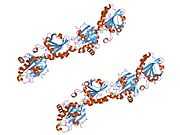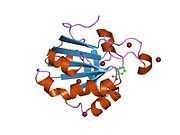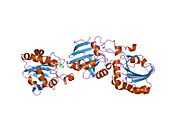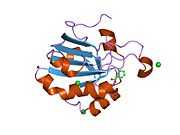PRDX5
| Peroxiredoxin 5 |
|---|
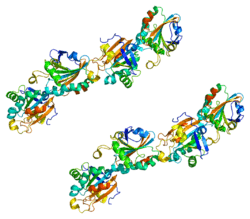
PDB rendering based on 1h4o. |
| Available structures |
| PDB |
Ortholog search: PDBe, RCSB |
| List of PDB id codes |
|
1H4O, 1HD2, 1OC3, 1URM, 2VL2, 2VL3, 2VL9, 3MNG, 4K7I, 4K7N, 4K7O
|
|
|
| Identifiers |
|---|
| Symbols | PRDX5 ; ACR1; AOEB166; B166; HEL-S-55; PLP; PMP20; PRDX6; PRXV; prx-V |
|---|
| External IDs | OMIM: 606583 MGI: 1859821 HomoloGene: 8076 GeneCards: PRDX5 Gene |
|---|
| EC number | 1.11.1.15 |
|---|
|
| Orthologs |
|---|
| Species | Human | Mouse | |
|---|
| Entrez | 25824 | 54683 | |
|---|
| Ensembl | ENSG00000126432 | ENSMUSG00000024953 | |
|---|
| UniProt | P30044 | P99029 | |
|---|
| RefSeq (mRNA) | NM_012094 | NM_012021 | |
|---|
| RefSeq (protein) | NP_036226 | NP_036151 | |
|---|
| Location (UCSC) | Chr 11:
64.09 – 64.09 Mb | Chr 19:
6.91 – 6.91 Mb | |
|---|
| PubMed search | | | |
|---|
|
Peroxiredoxin-5, mitochondrial is a protein that in humans is encoded by the PRDX5 gene.[1][2][3]
This gene encodes a member of the peroxiredoxin family of antioxidant enzymes, which reduce hydrogen peroxide and alkyl hydroperoxides. The encoded protein may play an antioxidant protective role in different tissues under normal conditions and during inflammatory processes. This protein interacts with peroxisome receptor 1. The crystal structure of this protein in its reduced form has been resolved to 1.5 angstrom resolution. This gene uses alternate in-frame translation initiation sites to generate mitochondrial or peroxisomal/cytoplasmic forms. Three transcript variants encoding distinct isoforms have been identified for this gene.[3]
References
- ↑ Yamashita H, Avraham S, Jiang S, London R, Van Veldhoven PP, Subramani S, Rogers RA, Avraham H (Nov 1999). "Characterization of human and murine PMP20 peroxisomal proteins that exhibit antioxidant activity in vitro". J Biol Chem 274 (42): 29897–904. doi:10.1074/jbc.274.42.29897. PMID 10514471.
- ↑ Knoops B, Clippe A, Bogard C, Arsalane K, Wattiez R, Hermans C, Duconseille E, Falmagne P, Bernard A (Nov 1999). "Cloning and characterization of AOEB166, a novel mammalian antioxidant enzyme of the peroxiredoxin family". J Biol Chem 274 (43): 30451–8. doi:10.1074/jbc.274.43.30451. PMID 10521424.
- ↑ 3.0 3.1 "Entrez Gene: PRDX5 peroxiredoxin 5".
Further reading
- Wood ZA, Schröder E, Robin Harris J, Poole LB (2003). "Structure, mechanism and regulation of peroxiredoxins.". Trends Biochem. Sci. 28 (1): 32–40. doi:10.1016/S0968-0004(02)00003-8. PMID 12517450.
- Hochstrasser DF, Frutiger S, Paquet N et al. (1993). "Human liver protein map: a reference database established by microsequencing and gel comparison.". Electrophoresis 13 (12): 992–1001. doi:10.1002/elps.11501301201. PMID 1286669.
- Kropotov A, Sedova V, Ivanov V et al. (1999). "A novel human DNA-binding protein with sequence similarity to a subfamily of redox proteins which is able to repress RNA-polymerase-III-driven transcription of the Alu-family retroposons in vitro.". Eur. J. Biochem. 260 (2): 336–46. doi:10.1046/j.1432-1327.1999.00162.x. PMID 10095767.
- Wattiez R, Hermans C, Bernard A et al. (1999). "Human bronchoalveolar lavage fluid: two-dimensional gel electrophoresis, amino acid microsequencing and identification of major proteins.". Electrophoresis 20 (7): 1634–45. doi:10.1002/(SICI)1522-2683(19990601)20:7<1634::AID-ELPS1634>3.0.CO;2-J. PMID 10424490.
- Zhou Y, Kok KH, Chun AC et al. (2000). "Mouse peroxiredoxin V is a thioredoxin peroxidase that inhibits p53-induced apoptosis.". Biochem. Biophys. Res. Commun. 268 (3): 921–7. doi:10.1006/bbrc.2000.2231. PMID 10679306.
- Seo MS, Kang SW, Kim K et al. (2000). "Identification of a new type of mammalian peroxiredoxin that forms an intramolecular disulfide as a reaction intermediate.". J. Biol. Chem. 275 (27): 20346–54. doi:10.1074/jbc.M001943200. PMID 10751410.
- Hu RM, Han ZG, Song HD et al. (2000). "Gene expression profiling in the human hypothalamus-pituitary-adrenal axis and full-length cDNA cloning.". Proc. Natl. Acad. Sci. U.S.A. 97 (17): 9543–8. doi:10.1073/pnas.160270997. PMC 16901. PMID 10931946.
- Declercq JP, Evrard C, Clippe A et al. (2001). "Crystal structure of human peroxiredoxin 5, a novel type of mammalian peroxiredoxin at 1.5 A resolution.". J. Mol. Biol. 311 (4): 751–9. doi:10.1006/jmbi.2001.4853. PMID 11518528.
- Rouhier N, Gelhaye E, Jacquot JP (2002). "Glutaredoxin-dependent peroxiredoxin from poplar: protein-protein interaction and catalytic mechanism.". J. Biol. Chem. 277 (16): 13609–14. doi:10.1074/jbc.M111489200. PMID 11832487.
- Wang MX, Wei A, Yuan J et al. (2002). "Expression and regulation of peroxiredoxin 5 in human osteoarthritis.". FEBS Lett. 531 (2): 359–62. doi:10.1016/S0014-5793(02)03511-1. PMID 12417342.
- Strausberg RL, Feingold EA, Grouse LH et al. (2003). "Generation and initial analysis of more than 15,000 full-length human and mouse cDNA sequences.". Proc. Natl. Acad. Sci. U.S.A. 99 (26): 16899–903. doi:10.1073/pnas.242603899. PMC 139241. PMID 12477932.
- Leyens G, Donnay I, Knoops B (2004). "Cloning of bovine peroxiredoxins-gene expression in bovine tissues and amino acid sequence comparison with rat, mouse and primate peroxiredoxins.". Comp. Biochem. Physiol. B, Biochem. Mol. Biol. 136 (4): 943–55. doi:10.1016/S1096-4959(03)00290-2. PMID 14662316.
- Banmeyer I, Marchand C, Verhaeghe C et al. (2004). "Overexpression of human peroxiredoxin 5 in subcellular compartments of Chinese hamster ovary cells: effects on cytotoxicity and DNA damage caused by peroxides.". Free Radic. Biol. Med. 36 (1): 65–77. doi:10.1016/j.freeradbiomed.2003.10.019. PMID 14732291.
- Salmon M, Dedessus Le Moutier J, Wenders F et al. (2004). "Role of the PLA2-independent peroxiredoxin VI activity in the survival of immortalized fibroblasts exposed to cytotoxic oxidative stress.". FEBS Lett. 557 (1-3): 26–32. doi:10.1016/S0014-5793(03)01437-6. PMID 14741336.
- Evrard C, Capron A, Marchand C et al. (2004). "Crystal structure of a dimeric oxidized form of human peroxiredoxin 5.". J. Mol. Biol. 337 (5): 1079–90. doi:10.1016/j.jmb.2004.02.017. PMID 15046979.
- Yuan J, Murrell GA, Trickett A et al. (2004). "Overexpression of antioxidant enzyme peroxiredoxin 5 protects human tendon cells against apoptosis and loss of cellular function during oxidative stress.". Biochim. Biophys. Acta 1693 (1): 37–45. doi:10.1016/j.bbamcr.2004.04.006. PMID 15276323.
- Dubuisson M, Vander Stricht D, Clippe A et al. (2004). "Human peroxiredoxin 5 is a peroxynitrite reductase.". FEBS Lett. 571 (1-3): 161–5. doi:10.1016/j.febslet.2004.06.080. PMID 15280035.
PDB gallery |
|---|
| | 1h4o: MONOCLINIC FORM OF HUMAN PEROXIREDOXIN 5 |
| 1hd2: HUMAN PEROXIREDOXIN 5 |
| 1oc3: HUMAN PEROXIREDOXIN 5 |
| 1urm: HUMAN PEROXIREDOXIN 5, C47S MUTANT |
|
|
|

